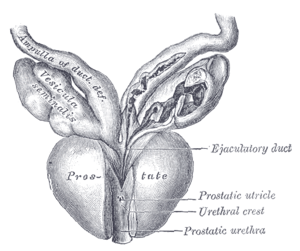Ejaculatory duct
| Ejaculatory duct | |
|---|---|

Male Anatomy
|
|

Vesiculæ seminales and ampullæ of ductus deferentes, seen from the front. The anterior walls of the left ampulla, left seminal vesicle, and prostatic urethra have been cut away.
|
|
| Details | |
| Identifiers | |
| Latin | Ductus ejaculatorius (Plural: Ductus ejaculatorii) |
| MeSH | A05.360.444.251 |
| FMA | 19325 |
|
Anatomical terminology
[]
|
|
The ejaculatory ducts (ductus ejaculatorii) are paired structures in male anatomy. Each ejaculatory duct is formed by the union of the vas deferens with the duct of the seminal vesicle. They pass through the prostate, and open into the urethra at the seminal colliculus. During ejaculation, semen passes through the prostate gland, enters the urethra and exits the body via the urinary meatus.
Ejaculation occurs in two stages, the emission stage and the expulsion stage. The emission stage involves the workings of several structures of the ejaculatory duct; contractions of the prostate gland, the seminal vesicles, the bulbourethral gland and the vas deferens push fluids into the prostatic urethra. The semen is stored here until ejaculation occurs. Muscles at the base of the penis contract in order to propel the seminal fluid trapped in the prostatic urethra through the penile urethra and expel it through the urinary meatus. The ejaculate is expelled in spurts, due to the movement of the muscles propelling it. These muscle contractions are related to the sensations of orgasm for the male.
Sperm is produced in the testes and enters the ejaculatory ducts via the vas deferens. As it passes by the seminal vesicles, a fluid rich in fructose combines with sperm. This addition nourishes the sperm in order to keep it active and motile. Seminal fluid continues down the ejaculatory duct into the prostate gland, where an alkaline prostatic fluid is added. This addition provides the texture and odor associated with semen. The alkalinity of the prostatic fluid serves to neutralize the acidity of the female vaginal tract in order to prolong the survival of sperm in this harsh environment. Semen is now a fructose-rich, alkaline fluid containing sperm as it enters the bulbourethral glands below the prostate. The bulbourethral glands secrete a small amount of clear fluid into the urethra before the ejaculate is expelled. The functions of this fluid are not entirely known but are suggested to aid in lubricating the male urethra in preparation for the semen during ejaculation. The amount of semen produced and expelled during ejaculation corresponds to the length of time that the male is sexually aroused before ejaculation occurs. Generally, the longer the period of arousal, the larger the amount of seminal fluid.
...
Wikipedia
